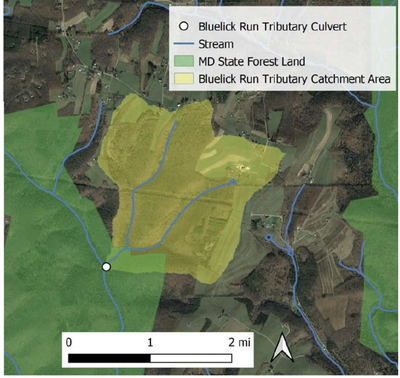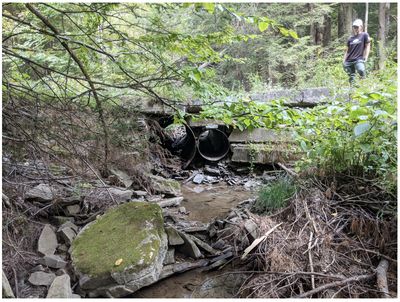Brook trout can move a little freer in Maryland's Blue Lick Watershed
In the summer of 2022, a collaborative partnership between the Eastern Brook Trout Joint Venture, Trout Unlimited’s Western Maryland Initiative, the Maryland Department of Natural Resources (DNR), and the US Fish and Wildlife Service successfully completed a major Aquatic Organism Passage (AOP) project on a tributary to Blue Lick Run, in the Savage River watershed in western Maryland. Efforts to improve connectivity in the Savage River watershed are important to maintaining population resiliency of Maryland’s best brook trout resource.
This project removed two ~20ft. long perched metal culverts which previously blocked access to 1.8 miles of headwater habitat. By removing this barrier and replacing it with a “fish-friendly” open-box culvert design, brook trout and other aquatic species can now access prime coldwater spawning habitat and thermal refugia.

Access to cold tributaries is critical to the natural life history of brook trout- providing both necessary spawning habitat as well as thermal refuge during low flow periods and warmer months. By reconnecting these habitats, TU, Maryland DNR, and partners have helped support the genetic diversity of local brook trout populations while also building their resilience to climate change.
The Blue Lick AOP project will serve as an important demonstration site for future collaboration between nonprofits, state, and federal agencies working to recover native brook trout. This is important as TU and partners look to address connectivity across the entire region: there are several similar fish passage barriers located throughout tributary systems in brook trout-bearing waters of western Maryland.

(Photo showing the Blue Lick tributary culvert as a barrier, prior to replacement. Undersized and poorly designed culverts block fish passage and contribute to flood damage, amongst other problems. Photo: TU).
Trout Unlimited’s Western Maryland Initiative aims to continue working with the Maryland DNR to monitor the Blue Lick site post-restoration. This will provide information on stream temperatures, aquatic communities, and habitat characteristics. This follow-up information means that partners will be better informed to take on future work to address the other barriers- reconnecting habitats and increasing the climate resilience of brook trout on a population scale.
"We are starting to see a shift in mindset with respect to road stream crossings across the landscape. It’s really exciting to be a part of and it just makes sense." - Abby McQueen, TU
Abby McQueen, Conservation Director, Mid-Atlantic and Southern Appalachian Regions for TU, had this to say: "We are starting to see a shift in mindset with respect to road stream crossings across the landscape. It’s really exciting to be a part of and it just makes sense. By replacing undersized failing culverts with larger structures that allow streams to flow more naturally through them, we are improving the aquatic and riparian life of these systems, but we are also decreasing the risk of flooding on the roads we drive on every day and increasing the lifespans of the structures themselves. Trout Unlimited is thrilled to have the support of the EBTJV and other partners like USFWS, MD DNR, and NFWF to enhance our native brook trout fisheries while also improving our local infrastructure.
About the EBTJV funding: As one of the twenty partnerships in the National Fish Habitat Partnership, EBTJV offers an annual RFP for project funding to conserve brook trout through habitat protection or improvement. In FY22, the program funded $172,598 across four on-the ground projects, including the Blue Lick Run Culvert Replacement. These projects together bring an additional $815,726 in partner contributions! The projects remove 3 barriers, reconnect 28 upstream miles, and improve 0.4 miles of stream. For more information on other EBTJV funded projects, see https://easternbrooktrout.org/projects.
Document Actions





